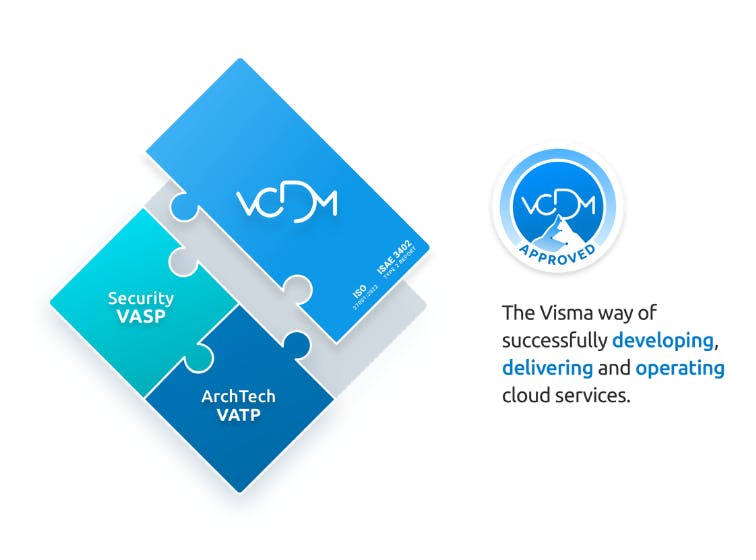Article
Voice of Visma Ep 06: Show notes
19/6/2024
min read
Business insights

On the Voice of Visma podcast, we sit down with leaders and colleagues from around Visma to hear their stories, learn from their expertise, and share the best lessons they’ve learned throughout their careers. These are the stories that shape us… and the reason Visma is unlike anywhere else. New episodes are released Wednesdays on Spotify, Apple Podcasts, and YouTube.
The text in this article is from Episode 06 and has been edited for length and clarity.

Welcome, Vibeke! Can you tell us a little about yourself?
Yes, of course. My name is Vibeke, and I work as a People Director in Visma. I have two kids, a husband, and a dog, and I’m based in Oslo, Norway, where I was born and raised. I spend most of my time working from the headquarters here in Skøyen.
Basically, I think I have kind of grown up in Visma. I’ve been here for 12 years. I started here fresh from school, where I graduated with a Master from Business Administration and Economics. And then I fell in love with Visma immediately and never left.
Employee engagement is huge for Visma. Why is measuring it so important?
This was actually one of the first processes that we rolled out on Group level in Visma, more than a decade ago. So, this is not a new area for us. I think the reason for this is that people, without a doubt, are our number one growth driver when it comes to succeeding in the business.
“Having the right people who are engaged, who love their job, and who loves to create value for the customers, that’s number one and why we succeed in Visma.”
So, I think that’s the big “Why”. And, as I said, it’s been on our agenda, high on our agenda, for many years already.
How has the process of measuring engagement changed over the years?
The process has changed a lot because Visma is a completely different company than it was 10 years ago. The world looks very different, as well. So, previously, and when we started originally, we had a bi-annual survey. We did this twice a year, sending quite extensive surveys where we asked questions about our people’s engagement and satisfaction. But then around three years ago when Covid hit, we learned how much things change within six months. Just within three weeks, society locked down. All people were sent home. So, we needed to think differently around several of our processes and this was the most important one of them. How do we keep engagement up? How do we still keep our people motivated and driven when they are all sent home without that interaction and the opportunity to inspire each other?
So, we looked into the tool that we were using and also the process that we had in place, and we realised that we needed to make some changes. It was no longer enough to check in once in a while and see how our people are doing. We needed to monitor this continuously. So, we changed completely both the tool and the process – going into more pulse surveys on a monthly frequency.
Now, we are luckily out of Covid, but the process still persists. And I think taking the temperature of how our people are doing and the culture of Visma as a group but also within teams and within companies is absolutely crucial for us.
“It’s changed quite a bit, and I would say it has become a much more integral part of our business. It’s as normal looking at and discussing our employee engagement data as it is looking at our financial numbers or customer data.”

How did people respond, going from the bi-annual surveys to monthly ones?
Well, as in any organisation, there were some people who thought it was a really great idea, and then there were some sceptics. And that’s fair enough! I think we found these both within our employees and our leaders, because having surveys twice a year means that you often also have more extensive follow-ups and action plans. The whole process of working with the data becomes quite big – or it can become quite big.
So I think one of the fears, of course, was how will we now do this on a monthly basis? We will not be able to do anything else. We will not be able to do our job basically. So, I think it was also a mind shift and a shift in how we think about employee engagement and how we work with employee engagement. And as of today, at least, I have not met a single leader that is not a big fan of the tool that we use, because it provides so much valuable data that we wouldn’t get access to anywhere else. And so much important data.
Speaking about the data… What do we actually do with all this great data that we gather?
That’s a great question, because it’s a lot of data with over 15,000 people! We do different kinds of things. First and foremost – and, naturally, the most important thing – is that this is the basis for how we work with our culture. This is the data that indicates where we are doing really well. What should we not change when it comes to our culture? And where do we still see that we have potential to be even better? And then we make use of this to start conversations with our employees and within teams to make small adjustments and improvements.
“I think this is an important part, as well, that the improvements and adjustments we make based on the Peakon data can be small tweaks. It doesn’t have to be these huge shifts. And I think that’s also part of the wonder of working with this continuously.”
Leadership
We measure employee engagement from many different angles, and one of those angles is leadership. So, we also have the Leadership Index in Peakon, which says something about how our leaders are doing based on feedback from their employees. As a leader, quite often you don’t get a lot of feedback. If you’re lucky, you have people that are comfortable providing you feedback – both constructive criticism and also praise. But it’s not something you get a lot, so you don’t always get to fill your blind spots.
We see that the leaders are the most important driver for our people’s engagement. So to give leaders also some feedback on how they’re doing and how they can improve is key. And I think the important part here is that we don’t measure our leaders to point fingers. We know that it’s not a popularity contest to be a leader. But we do it to fill the blind spot. And then, of course, give them the tools and the skills to excel and further develop in their role.

Visdom Project
I am also really, really happy to see that the data we have in Peakon has been embraced by so many different parts of the organisation. We have a group of people working on what we call the Visdom Project, where they go in and they look at correlations from a lot of different perspectives (not only a people perspective). We have also been able to make use of our Peakon data there and found some really, really interesting correlations of our own.
For instance, one particular example that I tend to speak about a lot is when our companies are going through their strategy processes, they work a lot with where they are and where they want to get to. Sometimes, it’s easy to forget to think about how to communicate this and how to make sure they bring everyone along for the ride. What the Visdom Project showed with analysing the people data, and Peakon data as well, was that teams and employees who understand and agree upon and are onboarded into the strategy of the company, they work on products that have a much higher Annual Recurring Revenue. These kinds of correlations are super interesting, and they really help us to see things that we might have overlooked otherwise.
“Of course, we’re extremely proud of being in the top 5% of the technology sector. And when it comes to employee engagement, naturally, we would also want to use that to sell Visma outwards for potential new colleagues and customers, as well.”
What other benefits do you see for the companies that measure their employee engagement?
Well, I think measuring engagement is one thing. I know there are many companies who are not doing that. I think I read somewhere that it’s only around 25% of companies that actually use technology to measure their employee engagement. So, that’s one thing. I think what makes a difference is what you do with the data and with the results.
“Everyone can measure but you need to work on it. You need to share the results, and you need to include your people. You need to work on it in the organisation as a team.”
This isn’t something that should be driven from leaders or from HR. It should come together with everyone taking part. And my strong belief, without having a lot of facts to build this upon, is that if you work on this data, you become more comfortable having conversations about things that are really great, but also things that could be improved. So, I hope it leads to a more open culture where we are also comfortable giving each other feedback.
One specific example we see in Peakon is companies where there is a lot of activity going on – because, as a leader, you can respond to comments that come in and you can have dialogs – that correlates quite often with higher employee engagement scores.
So, yes, I definitely think measuring is one thing; actually working on it is another. And that is what really makes the difference. There’s not an option to be able to hide things under the rug because the data and the results are there. And that leads to more transparency and openness and trust.

Final question: What does “Champions of business software” mean to you?
I guess it can mean a lot of different things and has different angles. To me, first of all, the word “Champions” stands out. I think you don’t become a champion unless you really have your heart in it. If you don’t have the passion, if you’re not engaged or driven to do what you’re doing, then you’re never going to end up a champion, so to say. And that resonates, of course, very well with the topic of this conversation.
Second, and maybe just as important, is the fact that you don’t become a champion alone either. Even individual athletes always have a team around them somehow. And, I think we are quite good at that in Visma.
“We have this stating also that we’re ‘Better together’, and that’s not just something a little bit fluffy that we say. We actually live it.”
I had a conversation once with a colleague in the management team. She had just come from a meeting where they had been discussing quite a tricky case. It wasn’t clear who should own the process. And then she came out of this meeting and she said, “What an awesome company we work in. Because you have this problem and there’s no real owner of it. And what do people do? They don’t lean back. No, they lean in. They raise their hands. They offer to contribute where they can. And then we fix it together”.
And I really agree on that. I don’t think I’ve ever been in a situation where I’ve asked someone to help and they have responded with, “No, that’s out of my role description or that’s not necessarily what I’m responsible for”. I don’t think I’ve ever seen that. And I think having that team feeling and people care, leaning in, and contributing also outside of your own scope makes us also be able to say that we are, in fact, “Champions” in our own way.
Listen to the Voice of Visma podcast on Spotify, Apple Podcasts, and Amazon Music. Or watch every episode on YouTube.
Voice of Visma
We're sitting down with leaders and colleagues from around Visma to share their stories, industry knowledge, and valuable career lessons. With the Voice of Visma podcast, we’re bringing our people and culture closer to you. Welcome!















































































































































































































































